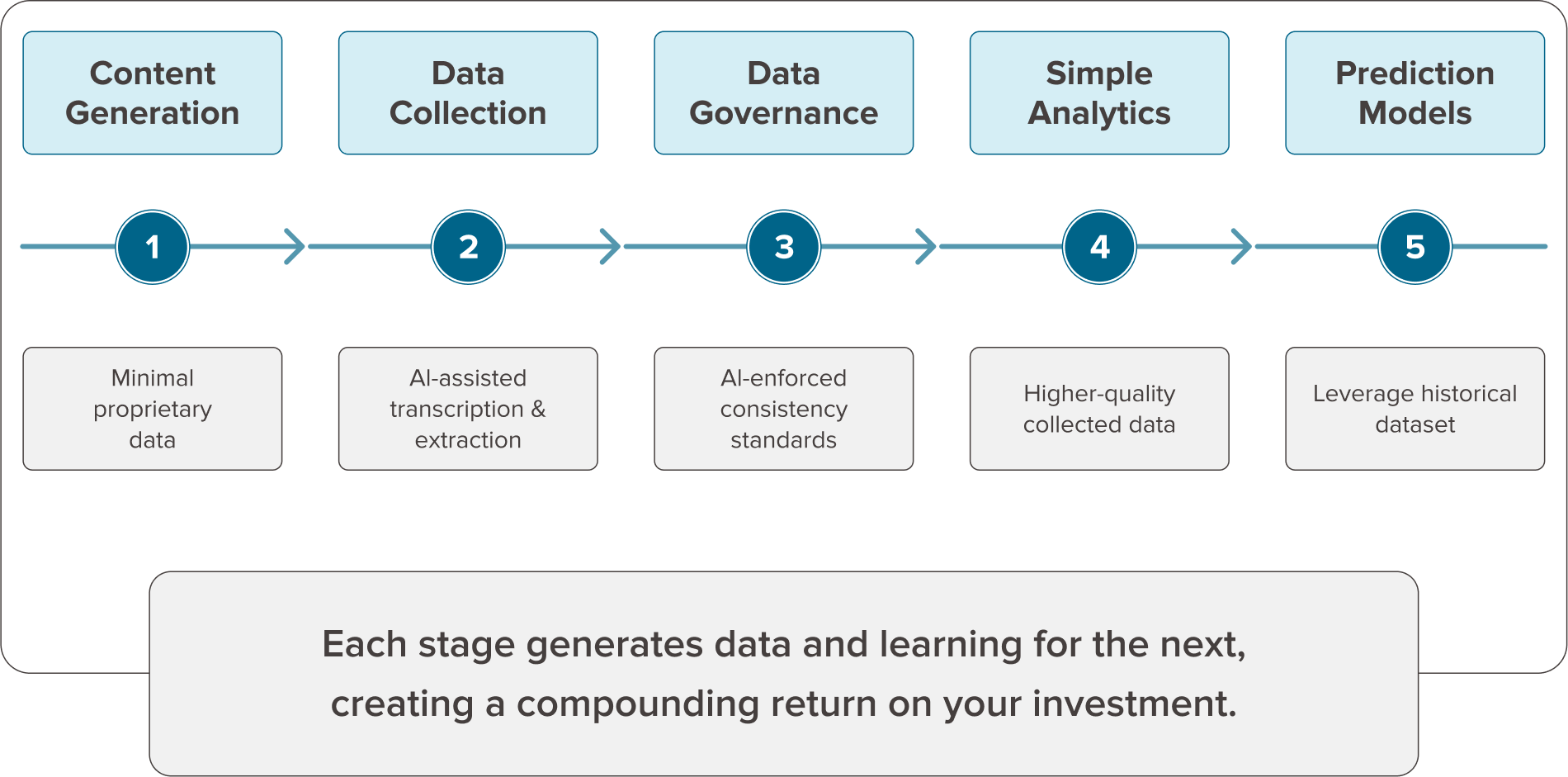Here are 5 different ways you can start using AI today with little or no dependency on existing data:
-
Use AI to Generate Data
Instead of waiting for perfect data to appear, use AI to create it:
- Extract key information from unstructured documents by having tools like ChatGPT or Claude pull key details from PDFs, contracts, or reports. This turns “dark data” into reusable insights.
- Transcribe team calls using tools like Otter, Fathom or Microsoft Teams’ built-in transcription. For example, if every department meeting was transcribed, people that were sick or couldn’t attend can catch up quickly – while you simultaneously build a valuable dataset for future use.
- Automate CRM updates with tools like Winn.AI or similar custom-built solutions you can dramatically enhance the quality in your CRM by suggesting field entries after calls, emails or meetings – letting your sales people do sales and not babysit the CRM.
-
Use AI to Improve Data
Rather than viewing data cleaning as a pre-AI task, use AI to improve your data:
- Enforce data governance rules with AI that automatically flags inconsistencies in your records. Imagine an intelligent policy check automatically applied to every new piece of data that enters critical systems.
- Clean up messy values in spreadsheets and databases by having AI identify and correct errors. This works surprisingly well, even without perfect training data – pre-trained AI can recognize patterns and anomalies based on context.
- Enhance data quality during collection by implementing real-time suggestions that suggest inputs intelligently or dynamically validate field entries – so data gets corrected before entering your system.
- Standardize inconsistent formats for names, addresses, and product descriptions across systems. I’ve seen teams use simple prompt engineering to normalize customer records in a fraction of the time it would take to create and implement rigid rules.
-
Use AI for Tasks That Don’t Need Your Data
There are lots of powerful AI use cases that actually don’t require any of your proprietary data:
- Draft routine communications using general-purpose LLMs. From emails and meeting agendas to project updates, these tools can generate high-quality first drafts without any training on your specific content.
- Generate creative content for marketing without extensive brand training. You can provide a few examples in your prompt and get immediately useful results that just need light editing to match your voice.
- Conduct research using AI services that support web search like Perplexity or ChatGPT search. These let you compile insights from across the web, saving hours of manual research.
- Create basic presentations that can be refined rather than built from scratch. AI tools like Beautiful or Gamma not only allow you to generate outlines and suggest content structure but also create final slide decks.
-
Use AI for Tasks That Work Well with Messy Data
Some AI applications are surprisingly resilient to data quality issues:
- SEO analysis and UX improvement. Even ChatGPT can analyze content and suggest improvements based on general on-page SEO principles just from your site’s raw HTML code or even screenshots.
- Support ticket categorization that quickly allows you to triage incoming emails with AI. Modern LLMs can quickly understand the intent behind customer messages and route them appropriately, even when customers express themselves in wildly different ways – across languages!
- Competitive intelligence gathering from varied public sources. AI can monitor news, social media, and websites to extract meaningful competitive insights without requiring a perfect taxonomy or data structure. In fact, AI can help you build this taxonomy as you go!
-
Use AI to Build a Knowledge Foundation
Of course, organizations that have a strong data foundation will eventually run circles around others that are just getting started. That’s why starting to use AI to build your internal knowledge infrastructure creates not only short-term value, but also long-term competitive advantage. Some standard use cases:
- Create simple question-answering systems on your existing documents using RAG. This works both for internal and external applications.
- Enhance search for knowledge bases without restructuring your information. Just replacing the keyword-based search component of your company’s wiki or knowledge base can help users find relevant information more reliably.
- Capture institutional knowledge from meetings and conversations using the AI transcription and summarization from above. While this rarely works completely automatically at scale, it has become much easier thanks to AI.
- Build learning loops. By tracking which answers work for users and which need refinement, you continuously improve your knowledge base without a massive upfront investment.
When You Actually Should Wait for Better Data
In the spirit of balance, there are legitimate cases where improving your data first makes sense:
- High-stakes decision systems where wrong predictions could have serious consequences (like healthcare diagnostics or financial risk models)
- Highly regulated environments with strict requirements for data governance and explainability
- When your existing data is actively misleading (e.g., reflecting biased historical decisions)
In these cases, a thoughtful data strategy is mandatory – but even here, you can often start with simpler AI applications in parallel with your data improvements.
Building Your Progressive AI Roadmap
The beauty of starting with AI now is that early implementations create the capabilities and data foundations for more advanced use cases – aka your AI Roadmap.
For example, a common progression I’ve seen work well:
- Start with content generation and knowledge tools that require minimal proprietary data
- Implement basic data collection through AI-assisted transcription and extraction systems
- Build improved data governance using AI to enforce consistency
- Develop simple analytics on the newly collected, higher-quality data
- Create prediction models that leverage the growing historical dataset

Each stage generates data and learnings for the next, creating a compounding return on your investment. The organizations that wait for perfect data often find themselves perpetually stuck at step zero.
At GAP, we specialize in building AI-powered software solutions and consulting tailored to different business growth goals. With 18 years of experience, we bring the expertise required to get the most out of generative AI benefits.
Choose a Gen AI consulting firm that understands your industry’s unique challenges. Partner with GAP today to optimize operations, enhance insights, and drive lasting impact. Get our free Gen AI strategy today, and let’s guide you through a successful AI adoption.


